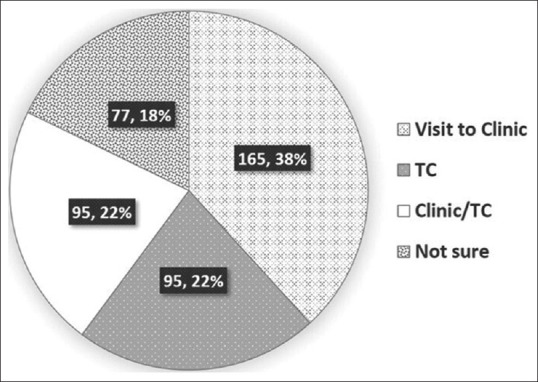Dear Editor,
Teleconsultation (TC) evolved mainly to reduce distance barriers and to provide quality medical care.[1,2] With the COVID-19 pandemic, the safety dimension for the patient and the practitioner also got included. While approximately 78% of ophthalmologists are utilizing TC after COVID-19,[3] it is not known if patients would be willing to utilize these services. We undertook an online survey for electronic gadget usage and as a part of it also wanted to understand the public’s willingness toward accessing teleconsultation services. Only the latter results are discussed here within the scope of this letter. The study protocol was approved by the institutional review board and was in accordance with the Declaration of Helsinki. Table 1 summarizes the development of the survey.
Table 1.
Summary of the methodology
| Description | Survey report |
|---|---|
| Survey development | Literature review followed by a discussion between four optometrists to finalize the contents of the questionnaire |
| Number and nature of items | 9 close-ended questions |
| Reliability | Not determined |
| Mode of survey | Internet-based (Google forms), anonymous |
| Survey period | October 2020-January 2021 |
| Sample frame | Open survey: School/college-going students and working professionals in India and few other countries |
| Target population | School/college going students and working professionals |
| Recruitment process | Emails and social media (such as WhatsApp, LinkedIn, and Facebook) accounts of LV Prasad Eye Institute; reminder sent 4 times |
| Participation | Voluntary participation |
| Survey administration | Sequential questions administered using Google forms |
| Informed consent | E-consent. Parents gave consent and filled the form for children (<16 years of age). |
| Number of screens | 5 |
| Review step | Review with back button; no alteration possible once the response is submitted |
| Data capturing | Automatic conversion into a Google spreadsheet |
| Data analysis | Descriptive statistics and Chi-square test |
| Software for statistical analysis | SPSS Version 20 |
The survey was completed by 432 participants (mean age ± standard deviation = 26.06 ± 13.92 years, 230 females and 307 adults (>16 years)); 393 participants were from India and the rest were from other countries.
Through our survey, we found that 44% of people were willing for teleconsultation for eye care, of which half of them (22%) only wanted a teleconsultation [Fig. 1]. A little over one-third of patients still preferred a physical consultation. This pattern was similar between participants in India and other countries, even with a small sample size in the latter group. Future studies can explore the barriers for uptake to improve the teleconsultation services.
Figure 1.

Pie chart demonstrating the types of consultation services preferred by the participants during the survey
Teleconsultation is the second most preferred choice among the survey participants. This reveals the familiarity and increasing popularity of this mode of eye care. In years to come, teleconsultation services have the potential to become the major healthcare delivery system. This will warrant changes in clinical management policy and measures for planning timely appointments, dynamic screening tools, and providing cost-effective treatments.
Financial support and sponsorship
Nil.
Conflicts of interest
There are no conflicts of interest
References
- 1. Currell R, Urquhart C, Wainwright P, Lewis R. Telemedicine versus face to face patient care: Effects on professional practice and health care outcomes. Nurs Times. 2001;97:35. [PubMed] [Google Scholar]
- 2. Baudier P, Kondrateva G, Ammi C, Chang V, Schiavone F. Patients' perceptions of teleconsultation during COVID-19: A cross-national study. Technol Forecast Soc Change. 2021;163:120510. doi: 10.1016/j.techfore.2020.120510. [DOI] [PMC free article] [PubMed] [Google Scholar]
- 3. Nair AG, Gandhi RA, Natarajan S. Effect of COVID-19 related lockdown on ophthalmic practice and patient care in India: Results of a survey. Indian J Ophthalmol. 2020;68:725–30. doi: 10.4103/ijo.IJO_797_20. [DOI] [PMC free article] [PubMed] [Google Scholar]


